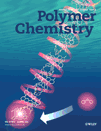Bioreducible and core-crosslinked hybrid micelles from trimethoxysilyl-ended poly(ε-caprolactone)-S-S-poly(ethylene oxide) block copolymers: Thiol-ene click synthesis and properties
Abstract
Bioreducible and core-crosslinked hybrid micelles were for the first time fabricated from biodegradable and biocompatible trimethoxysilyl-terminated and disulfide-bond-linked block copolymers poly(ε-caprolactone)-S-S-poly(ethylene oxide), which were prepared by combining thiol-ene coupling reaction and ring-opening polymerization. The molecular structures, physicochemical, self-assembly, and bioreducible properties of these copolymers were thoroughly characterized by means of FTIR, 1H NMR, gel permeation chromatography, differential scanning calorimetry, wide-angle X-ray diffraction, dynamic light scattering (DLS), and transmission electron microscopy. The core-crosslinking sol-gel reaction was confirmed by 1H NMR, and the core-crosslinked hybrid micelles contained about 3 wt % of silica. The bioreducible property of both uncrosslinked and core-crosslinked micelles in 10 mM 1,4-dithiothreitol (DTT) solution was monitored by DLS, which demonstrated that the PEO corona gradually shedded from the PCL core. The anticancer doxorubicin drug-loaded micelles showed nearly spherical morphology compared with blank micelles, presenting a DTT reduction-triggered drug-release profile at 37 °C. Notably, the core-crosslinked hybrid micelles showed about twofold drug loading capacities and a half drug-release rate compared with the uncross-liked counterparts. This work provides a useful platform for the fabrication of bioreducible and core-crosslinked hybrid micelles potential for anticancer drug delivery system. © 2012 Wiley Periodicals, Inc. J Polym Sci Part A: Polym Chem, 2012




